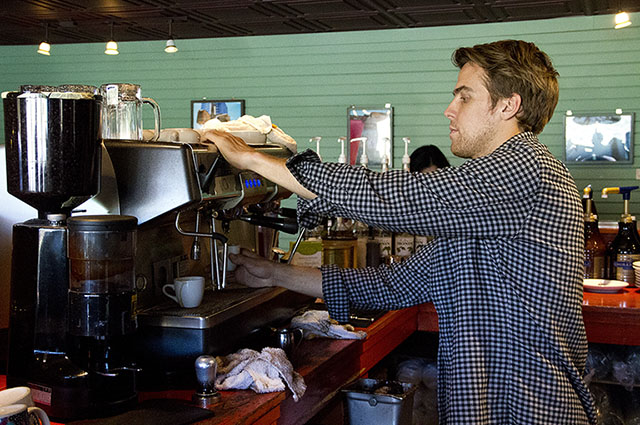Competition and Survival in a Cup of Coffee

Jesse Hill makes a Don Quixote, one of the mocha drinks named after literary characters at Bennu Coffee. Photo by Oscar Ricardo Silva.
By Wendy Rubick
For Reporting Texas
AUSTIN – La Tazza Fresca, a locally owned coffee shop on 37th Street, is across Guadalupe Street from a Starbucks on 38th Street, a proximity that mirrors the financial realities of coffee shops in Austin: the fragile co-existence of small businesses and corporate giants.
La Tazza Fresca, which opened in 2002 before its Starbucks neighbor, seems to be doing well. But if the recent closures of downtown stalwarts Café Mundi, Little City Espresso Bar and Café and Ruta Maya Café are an indicator, quirky, privately owned coffee shops here may be in danger as rents continue to rise in Austin.
Daniel Hamermesh, a University of Texas professor of economics, said the efficiency of service and low cost of Starbucks coffee give it an edge over independents. According to the company’s 2011 annual report, Starbucks has 10,787 locations in the United States. About 50 are in the Austin area.
“Infant business mortality is huge,” Hamermesh said. “We talk about companies dying, companies being born; most new companies are small; most companies that die are small.”
Still, Hamermesh forecasts economic improvement, a decrease in small-business foreclosures and equilibrium in the coffeehouse market. Despite the number of mom-and-pop shops that are closing, others remain open, and new businesses are popping up. For instance, Vintage Heart Coffee opened in downtown Austin in May.
John Butler, a business professor at UT and director of the Herb Kelleher Center for Entrepreneurship, said the difficulty start-ups face is a low barrier to entry, resulting in higher competition and lower profits.
Austin independent coffee shops compete with 50 nationally recognized operators – The Coffee Bean and Tea Leaf, Peet’s Coffee, Caribou Coffee, and of course, Starbucks – that dominate 70 percent of the market, according to a 2012 quarterly report by the Austin-based market research firm, First Research.
Mark Kamburis, co-founder of Flipnotics Coffeespace, said his business was one of a few coffee shops in Austin when it opened in 1992. Flipnotics had a 15- to 20-percent sales decrease after a Starbucks opened a mile away, but sales stabilized six months later, he said.
“Trying to compete with the big guns, the Starbucks, etc., was very challenging,” said Kamburis, who sold Flipnotics in 2009. “It was always in the back of our mind what could happen to our livelihood.” Starbucks did help independents by launching the coffeehouse craze, Kamburis said.
Quirky local shops survive in Austin because of the city’s support for locally owned businesses and its love of coffee, Bennu Coffee co-owner Stephanie Williams said.
“Austin is known as the ‘Seattle of the South’ in terms of our coffee,” Williams said. Bennu, a 24-hour independent coffee shop, opened on East Martin Luther King Boulevard in 2009.
Steve Williams, who owns Bennu with his wife, Stephanie, said his customers are a mixture of businessmen, families, artists, and bar employees as opposed to the artistic crowd that frequented independents before the chain’s arrival in Austin in 1995.
“If anything, Starbucks helped Bennu by opening the possibility of going to a coffee shop to a broader audience,” Steve Williams said. Starbucks established $3 or $4 as a fair price for a latte, which helped the industry, Stephanie Williams said.
Launching a coffee shop requires relatively low start-up costs, about $20,000 to $30,000, said Randy Moon, a national small business consultant for Amera Consulting. He said that “respectable” profits—$2,000 to $5,000 a month—don’t occur until the middle of the second year.
In addition, banks are making fewer high-risk loans for restaurant and coffee shop start-ups, which have a high rate of failure. The owners of Bennu said they turned to an investor because of problems with securing a loan.
Kamburis, who now owns the Satellite Bistro & Bar in Austin, said that independents usually have higher operating costs than corporate chains, which have larger financial resources, and the ability to divide costs among several locations as well as to hire lawyers to negotiate rent.
Several higher-profile coffee shops that closed downtown said they were victims of rent increases.
Jessica Nieri, the former owner of Café Mundi on the East side, told The Austin Chronicle that she faced a 100 percent increase in rent before the shop’s closure in 2010. Tim Sheehan, owner of Ruta Maya Café on South Congress, told The Chronicle that the increasing cost of rent was a factor in the café’s closure in September.
Benoit Rochard, an associate at Urbanspace Commercial, said that commercial-property rental rates are rising because many out-of-state businesses are coming to Austin. At the same time, fewer residents are relying on vehicles for transportation, resulting in increased foot traffic in the downtown area.
Moon said the climate is improving for fledgling, independent coffee shops because the economy is getting better. “It’s a good time—not a great time—but still a good time. And Austin’s a college town, so independents should do well there,” he said.